After riting to you from Chocolá, I went up to Kesaltenango: where I got a copy, which haz been useful to me, ov a privat map ov the Koopóm country. I also got a set ov unpublisht fotos to send you, ov the Chaculá colection ov antiquities. The weather waz getting dry in Kesaltenango, but in the northern country, beyond the Kuchumatán mountains, it waz stil very wet. All you could see ov thoze mountains, in the distance, waz a bank ov black cloud. In the mean time, til that country should get dry, I determind to make a journey to Soconúsco (that iz to say, to that part ov the Pacific slope ov Chiapas which iz next to Guatemala), and there see some mounds that I had heard ov, said to be a little beyond the Mexican frontier. I found the mounds: they wer in the neibourhood ov Little Tústla (Tustla Chico). But accidentaly, in the same neibourhood, I found something much more intresting. I came across a great stone, or bowlder, most ov it embedded in the ground, but partly above ground: and in that part plainly sculptured with the signs ov the twenty days.
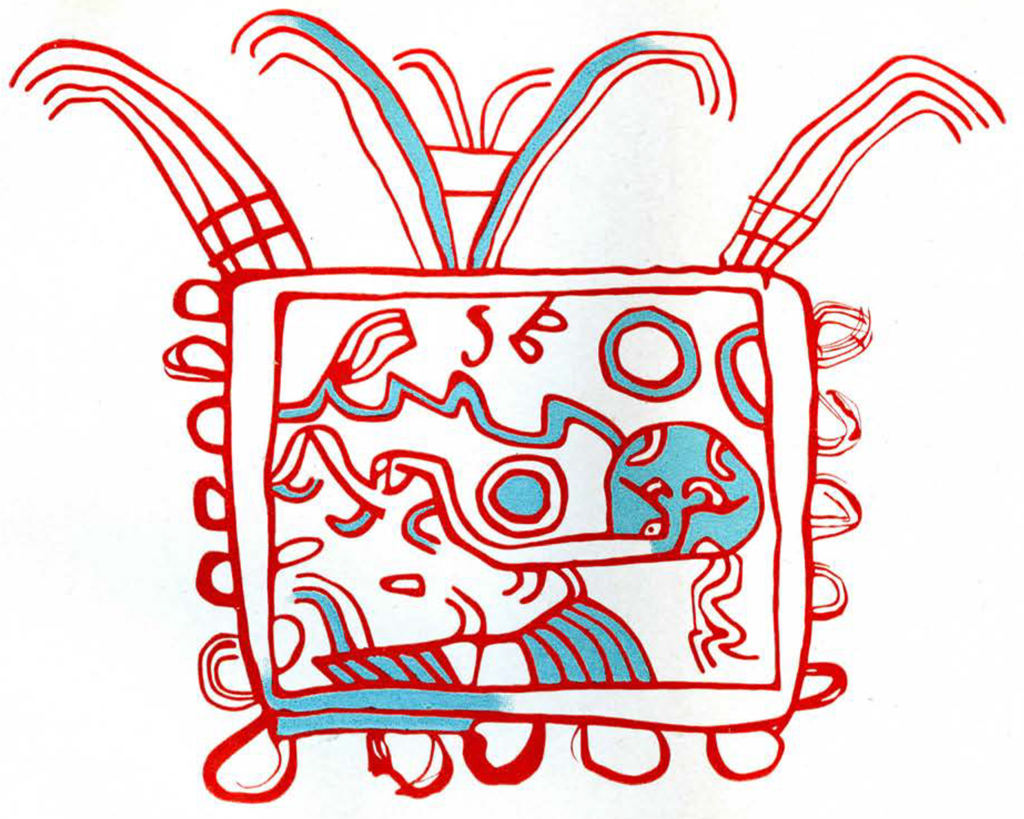
And I came across something else, in that journey. Coming back from Soconusco, the point I waz headed for waz Chiantla, at the foot ov the Kuchumatáns: and my way up there from the Pacific, took me past the volcano ov Tahumúlco, which iz the highest mountain in Central America. I happend to hear that Indians ov the neibourhood spoke ov some cave on that mountain, and ov strange ritings, or pictures, on the side ov the cave: and it struck me that that might be something for the Muzeum Journal. The cave turd out to be a clif, at a height ov about twelv thouzand feet above the sea: and the drawings, which ar in red and green, to be aparently, things ov a hieroglyfic nature. I made two expeditions to the clif, the second time with tracing paper, and by making ladders, I waz able to get up and copy the best ov the drawings.
It waz then about the middle ov March. A few days later, after reaching Chiantla, I waz caught, and delayd, by Holy Week. Traveling east to Kunén, I then crost the Kuchumatáns, and went down on the other side through Chipál.
I send you, given by Mr. Gustavus Kaehler ov Kesaltenango, a set ov unpublisht fotografs, showing the Chaculá colection ov antiquities, az it was in the time ov the colector. The colection iz now, in great part, destroyd or lost.
Chaculá, in Guatemala, and the neibouring Sakchaná, in Chiapas, have been ritten ov, as you know, by the late Mr Edward Seler, who vizited them about 1896. The owner ov the Chaculá estate, and the maker ov the colection, waz a countryman ov Mr Selers, the late Mr Kanter. The estate waz a cattle estate, and Mr Kanter waz one ov the principal graziers ov that part ov the country. Mr Selers vizit turnd him into an antiquary. He began diligently gathering antiquities: some from az far off az Comitán, but most from hiz own neibourhood ov Chaculá and Keen Santo: forming by degrees what came to be known az hiz muzeum: which returning from Mexico, I my self once saw. Kanter also took to reading books, and deducing hiz own theories from them. Evry-thing turnd on Tibet. From Tibet az a centre, arts and manners spread over the face ov Asia: but the seeds ov thoze arts and manners wer brought to Tibet from Chaculá: I forget by what means. Whatever might be the case with hiz theories, however, ther could be no dout about the great intrest ov hiz colection: which waz reputed to be the largest privat colection existing, ov Guatemala antiquities.
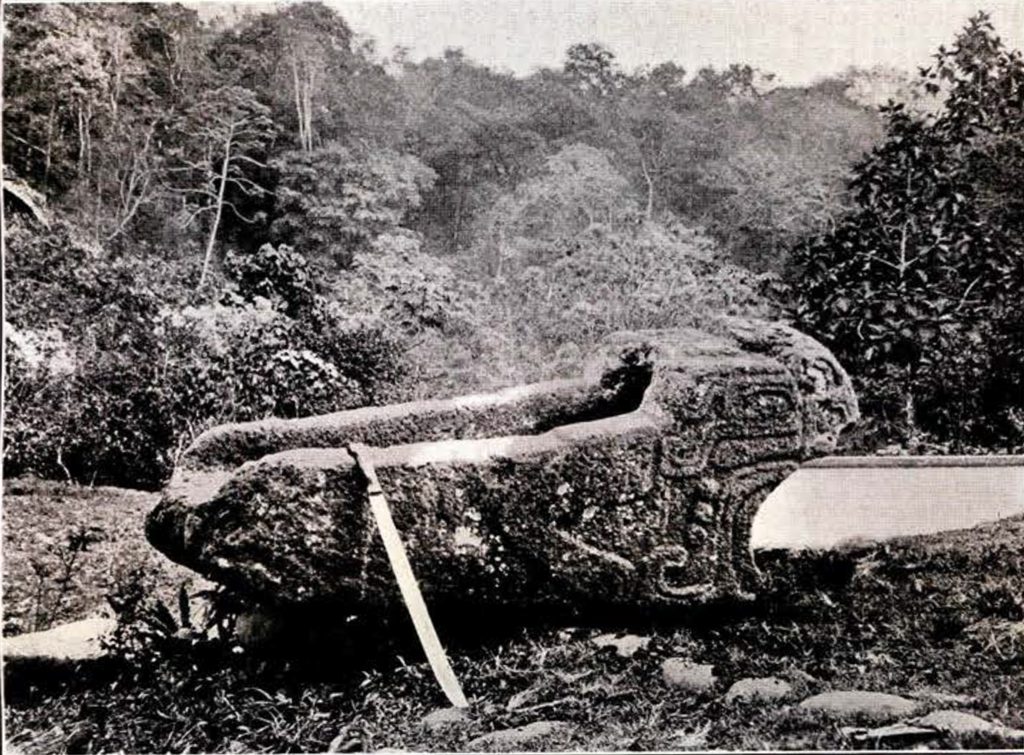
Kanter and hiz colection wer both destind to dizaster. Kanter, who had always been adicted to meddling in nativ politics, in hiz old days drew down the displeasure ov the Guatemala dictator, and az lye told you before, had to fly the country, and died a refugee in Chiapas. The Chaculá estate waz given over to pillage and ruin. For some time troops wer quarterd on it: and the operations ov the bare-footed soldiers extended in full severity to the muzeum. I am informd that things ov stone, that wer too massiv to be eazily stolen or broken, stil remain: but ov much the greater number ov things, and ov much that waz most atractiv, theze fotografs ar the only record.
Theze fotografs, which wer the only fotografs ov hiz antiquities that Mr Kanter ever alowd to be taken, and wer taken by Hz son in law, that iz to say by Mr Kaehler himself who now givs them to you, you will find to be thirty five in number.
I also send fotografs that I hav made ov stones in the neibour-hood ov the river Suchiate: that iz to say, in the neibourhood ov the frontier between Guatemala and Chiapas, in the part next the Pacific.
The Pacific slope, in the neibourhood ov that frontier, iz dominated by two companion volcanos: one ov which iz entirely in Guatemala. That one, which iz Mount Tahumúlco (Spanish spelling Tajumulco), and the highest mountain ov Central America, iz the mountain that you hav a hazy view ov in foto 120. The view iz from the seaward side: and the left hand side, in the picture, iz the side towards the companion volcano ov Tacaná: which iz partly in Guatemala and partly in Chiapas. The little boundary river, or torrent, ov the Suchiáte comes down between the two volcanos. Tocaná, which iz only a little lower than Tahumúlco, iz the mountain you see the top ov in foto 121: and the Suchiáte river, invizible, iz in the bush below you, near the bottom ov the picture. You stand on the Guatemala side ov the river, but most ov the country that you see iz Mexican: it iz the part ov Chiapas that iz calld Soconúsco. And that foto may giv you an idea ov what most ov the country there looks like, no matter on which side ov the river. In the other foto, 120, you see the country very broken: you ar already high among the foot hils: but once below the foot hils, az you see in the fore ground ov 121, the apearance iz the general apearance ov the Pacific slope: the apearance ov one steady slope, in which the actual ups and downs, rivers, villages, coffee plantations, and all diversifications, ar lost under the uniform mask ov bush.
The stone, 806, waz at a place La Riója, on the Soconúsco side ov the Suchiáte.
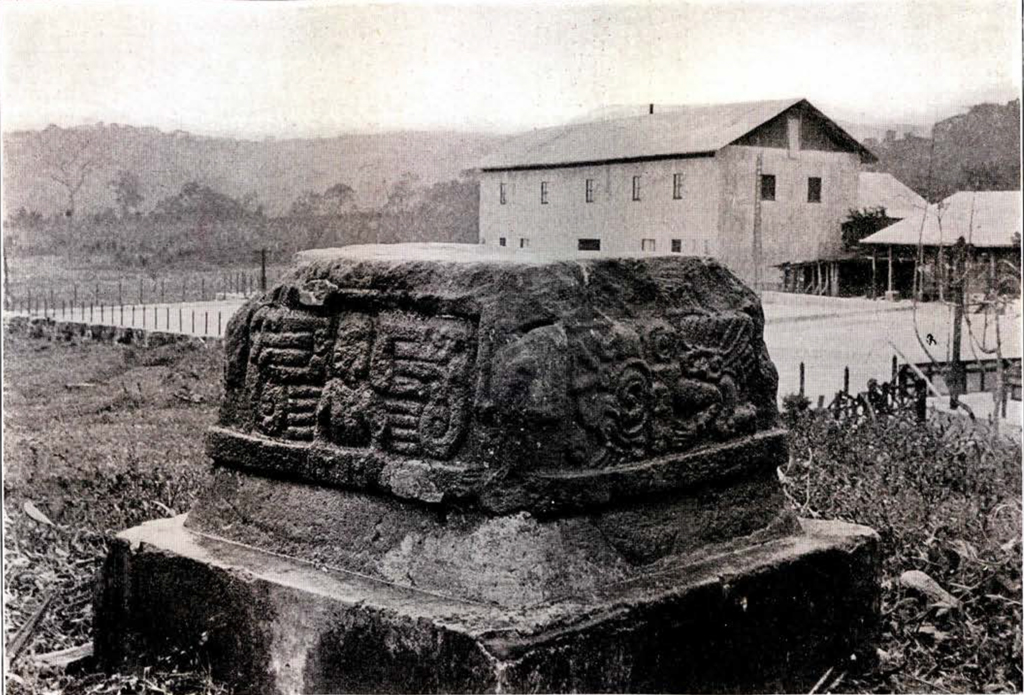
On that side ov the Suchiáte you will find markt, on most maps, a village calld Tustla Chico, or Little Tústla. A little above that, ther iz a smaller village Cacawatán: which you may find spelt Cacaoatán, or Cacahuatán, or Cacaguatán, or in some other way. The place La Rióha iz a coffee plantation, a little to the west, or to the north west, ov that Cacawatán: and perhaps twelv hundred feet above the sea.
I had been informd by a man who had known the place, La Rióha, that ther wer a number ov artificial mounds there: and that one ov them, which the owner had had the curiosity to dig up, had been found to contain a great quantity ov very hansome things, both pottery and stone: a quantity described az being near a ship load: which the owner, being a Spaniard, had sent to Spain. From experience, I expected that I should find a good deal ov exaggeration, not to say lies, in the acount: but I must say, not quite to the extent that I actualy found. The Spanish owner waz real. I found him: and he waz able to show me a mound, in which he, or hiz father, had once dug a hole: but finding nothing in the hole, they had stopt digging. Az for the ship load ov things sent to Spain, they had never sent anything to Spain, and the ship load ov things could only amount to this, that they had realy found on the place, a certain big carvd stone: which the man took me to see.
My fotografs show you the stone. You see that the head haz the lower jaw nockt off, and the upper jaw damagd: and that reptilian head, with the indication ov the number three, haz arms apended to it, but nothing else. The back part ov the stone iz cut into the shape ov a trough, which opens downwards into the throat and mouth ov the head. The stone where you now see it, iz near a house and a coffee yard, and the trough iz some times uzed az a manger: but the stone was dragd there with great labour, az a curiosity. The original place ov the stone waz near the mound: and the posture waz like that ov the Chocolá stones: the carvd stone had a big flat stone under it.

Leaving La Rióha, or Cacawatán, to go back to Guatemala, I waz headed up hil. The more natural way would hav been to go down to Little Tústla, and cross the Suchiáte by a good road. However ther waz some trouble in that direction, and I waz to take a ford: and the ford that I waz bound for, and in fact crost by (and from beyond which I took the foto 121), waz at a place—Ive forgotten its name, but several leagues up from Cacawatán. The Rióha stone had shown that I waz in a region ov sculptured stone. And going up, az lye said, to my ford, I had word ov an other sculptured stone, which had been found on an other coffee plantation, Saint Jerom (Spanish, San Jerónimo), which would not be much out ov my way. I went to Saint Jerom, and my fotograf shows you the stone (807).
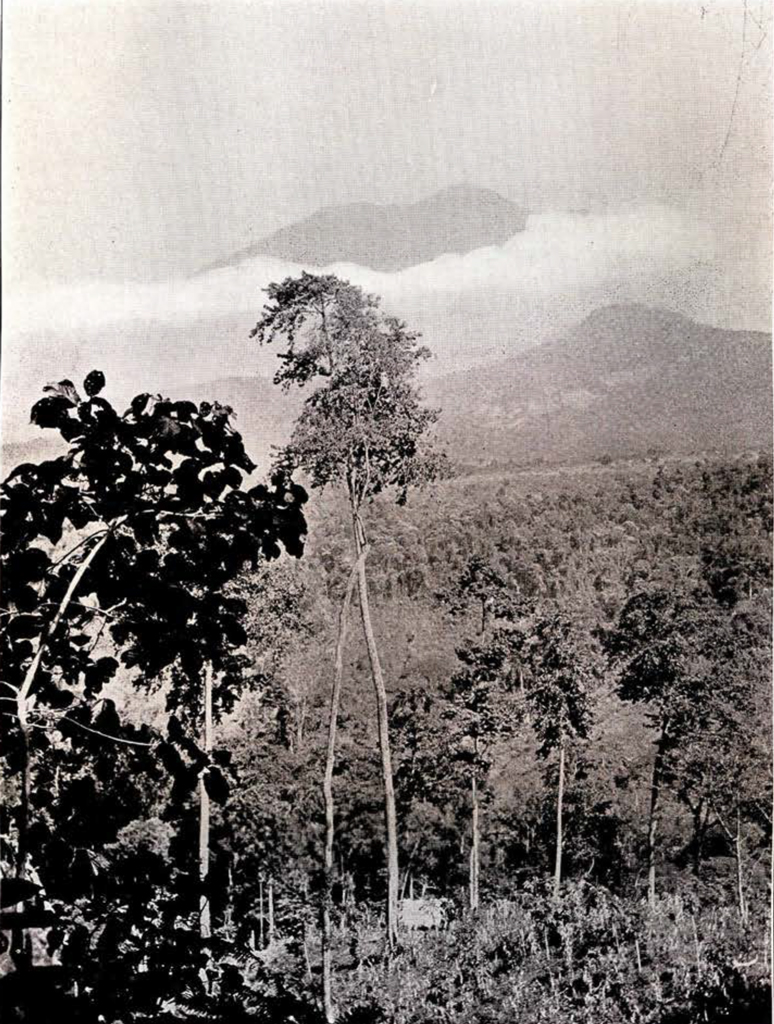
Like the Rióha stone, this stone iz not in its original place. The original place waz at the foot ov a small artificial mound: the stone where you see it, iz on top ov that mound. It happend that the mound had been taken az a land mark: and the owner ov the land put a small masonry monument on the mound, and uzed the ancient stone az a cap for the monument. In the fotograf you distinguish at once the ancient sculptured stone, its lower border jutting out beyond the pedestal. The owner, or hiz mason, at the same time mended the apearance (az they considerd) ov the batterd ancient stone, by a coat ov plaster on the upper and lower borders: by good luck the plaster waz bad, and all that iz now left ov it, iz two small patches that you may notice, on the left hand side: one above the sculpture, and one below.
The stone iz a flat stone, about a foot high, and two feet square, and sculptured on the four sides: ov which the two that you see, taken together, ar the two that ar least damaged. In the left hand sculpture, you notice that the human figure haz its hands, az you might say, outside the picture, resting on the border. The defaced head ov the figure, iz no more to be made out on the stone itself than in the fotograf. On the oppozit, and worse defaced side ov the stone, that you dont see, it could be made out that the sculpture waz like this in scheme, but different in detail.
The right hand sculpture, that you see (which may seem to involv a Mexican day sign, with arms and legs, and perhaps wings, added), iz repeated exactly on the oppozit side ov the stone: with only this difference, that the figure, in stead ov looking towards the beholders left, looks towards hiz right, and consequently in the same direction az the figure that you see. I tried to find out in what direction the stone, or any side ov it, had originaly faced, but nobody rememberd. It waz only rememberd that the stone had been taken from the eastern foot ov the mound.
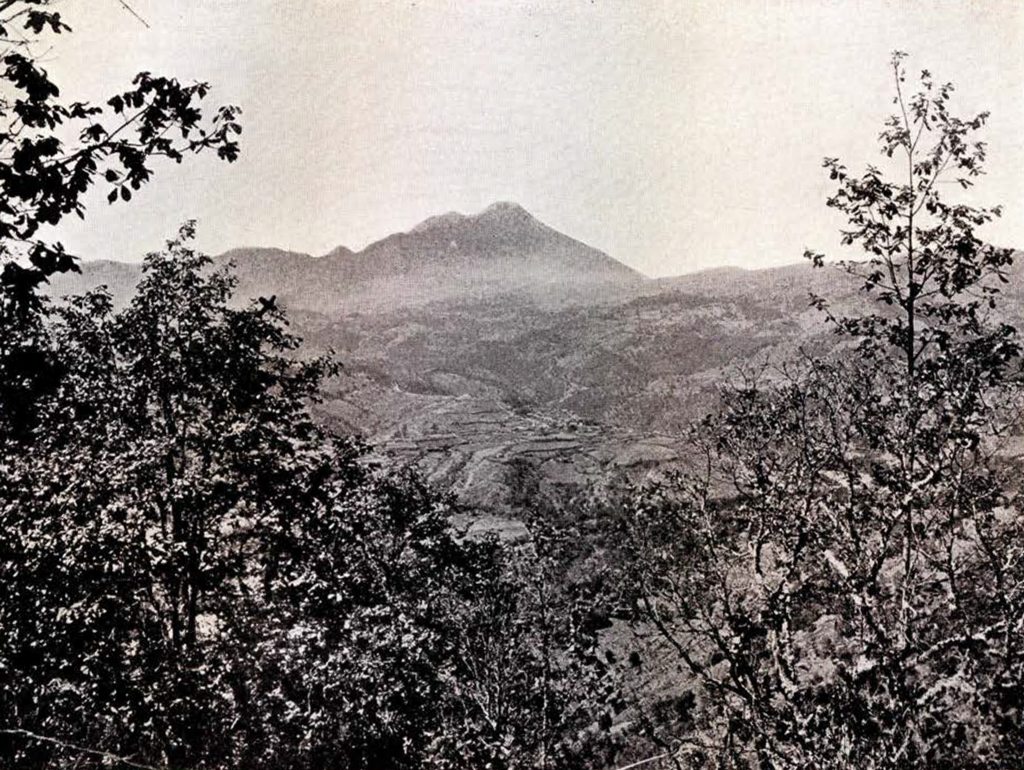
Image Number: 175834
It turnd out, however, that this waz not the only sculptured stone at Saint Jeroms: I waz shown two others: neither ov which, so far az waz known, had ever been moved. The place ov thoze two others (which ar near together) iz a little to the right ov the picture you wer looking at, and above thoze coffee yards and tin barns. Ther ar, or wer, some work mens cabins up there: and one ov the stones waz to be seen inside one ov the cabins, in the middle ov the floor. It waz a stone carvd in the shape ov a gigantic lizard. The lizard, which may hav been four or five feet long, but had its head missing, waz stretcht out on a sort ov stone table: the lizard and the table being one stone: and the hole thing, which roze to perhaps a foot above the floor, waz imoveable. The lizard and the table wer nothing but the top ov some great stone, perhaps a natural rock, the rest ov which waz under ground.
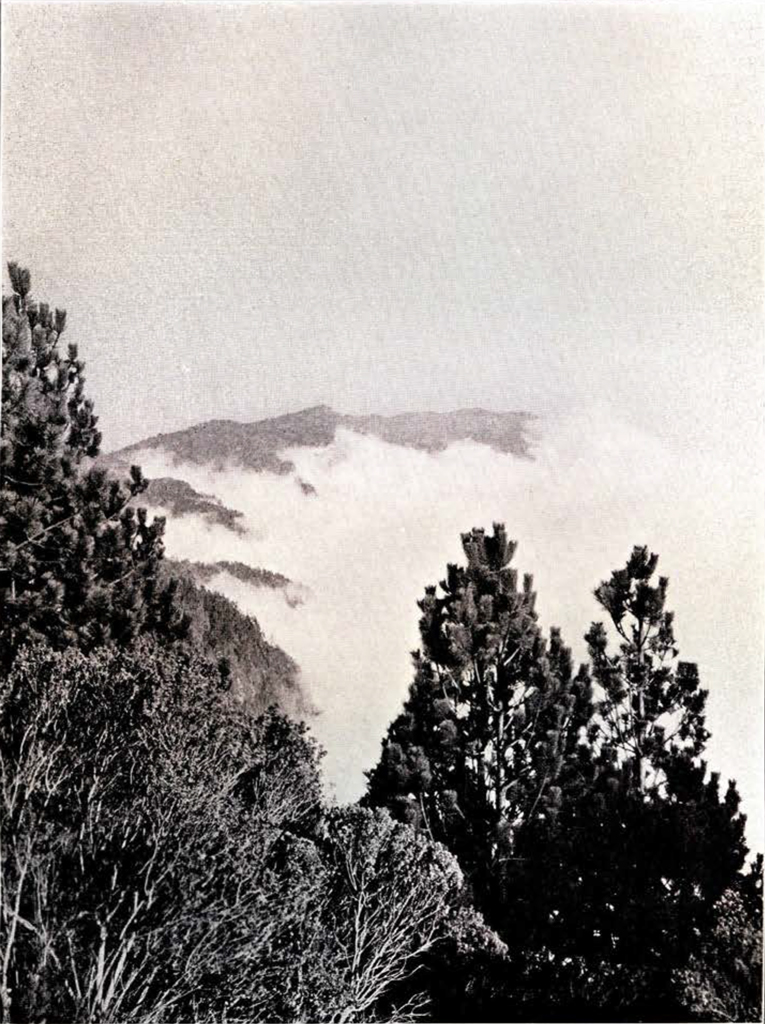
A few steps away from the cabin waz the other stone: which I found to be the least spectacular, and much the most intresting ov the three. That stone, like the lizard stone, waz evidently some great stone, or bowlder, ov which only a little waz above ground. That little that you could see, waz an iregular, roundish hump ov stone: I should say, from memory, about a foot high, and rather less than the length ov a man in diameter. The people had told me that the stone had drawings on it: in particular, the drawing ov a deer. The drawings turnd out to be low reliefs, ov an inferior workmanship to thoze ov 807, and a good deal abraded, but little broken. The deer waz quite plain: and they waz a dog, and a lizard, and a bird, and a snake: and in a few moments I waz aware that I waz looking at the signs ov the twenty days. It grew dark az I waz making out the signs: and az people further on wer waiting for me, I waz not able to stay til morning: and I am not certain whether all the twenty signs wer comprized in the vizible part ov the stone: but if not all the twenty, certainly the greater number. Each sign occupied a space about az big az your hand, or az big az your two hands: and what gave me much trouble, they wer not in order. They were not in either ov the two obvious orders that might be lookt for, nor in any orderly arangement at all, that I could see, but formd a haphazard crowd: and in that respect (though in no other respect) reminded me ov the whimzical distribution ov them in the drawing in the Turin manuscript.
The owner ov the place told me that he had once been curious to see how deep the stone went, and dug down on one side about a fathom, without getting to the bottom. It happened at that moment ther waz a heavy rain, and the pit that waz dug waz find with water, and a drunken man waz drownd in it. The digging waz then considered unlucky, and the pit was find up. But if anybody else wishes to dig, the owner—a very pleasant nativ—will be happy to let them.
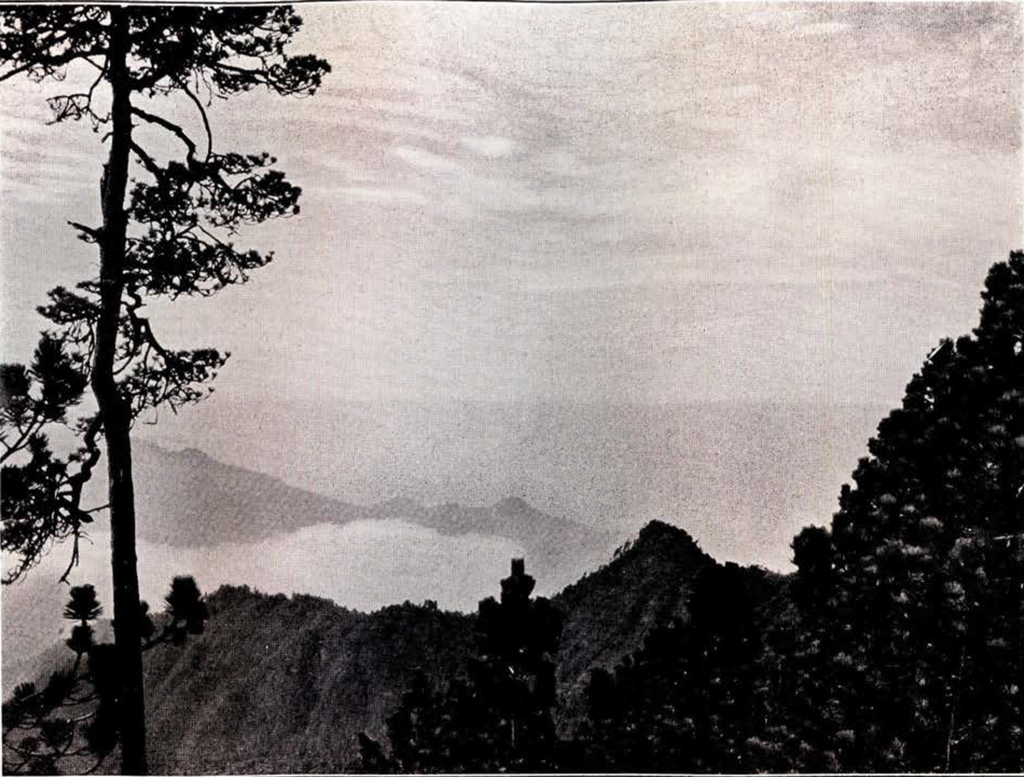
This sketch iz not drawn to scale, but wil do to bring out the situation. In going up from the hot country ov Malacatán to the cold country ov Tehútla, and further inland, the usual way, and the only way that most travelers ever car ov, iz by a bridle road which climbs round the western side ov Mount Tahumúlco. On that road iz the tiny village which givs its name to the volcano. But the Indians ar acquainted with a shorter, and what iz doutless the ancient way. That way, which iz markt on my sketch with dots, iz a steep foot path, crossing the mountain a little to the east ov the top: and may be reprezented az joining the coffee plantation ov Porvenír (which iz among the foot Nils ov the Pacific side) with the lofty inland hamlet ov Saint Sebastian. The clif ov the drawings iz on that path. By that path you can get to the clif either from the Pacific, or from the inland side: and at different times I went both ways.
Coming from Soconúsco, my first way, naturaly, waz from the side ov the Pacific. The plantation ov Porvenír (where I waz obliged to the manager, Mr Thiemann, for much valuable help) waz my starting point: and the foto 120, that you saw, waz taken from there. The top ov the mountain, in that foto, iz a little east ov north: and to the right ov the top, you see a hump calld Conception Hil: which runs down further to the right, in a ridge, or spur, with a sharp point on it. That sharp point iz calld Bull Hil. The place ov the clif iz beyond anything in sight: but the path to it, goes up to the saddle, that you see, between Bull Hil and Conception Hil: after which, the path doeznt go down on the far side ov that saddle, but goes on, and stil up, on the side ov the main mountain.

The manager and others, ov Porvenír, wer not themselves aquainted with the clif : and the Indians who new it, and wer afterwards my guides, described it az a cave—a cave with ritings or pictures, on the sides: and I expected to go into a cave, and took candles, and magnesium light with me. In stead, I waz shown a crag, or clif, about fifty feet high. The clif, which iz very broken and uneven, in its short length, in places a little over hangs: and in one place, at the foot, ther iz a shallow recess, in which a traveler, caught by night, would hav some shelter from rain, or from hail, though very little (az I found by experience) from wind and cold. But excepting for that little shelter (to the Indians the only thing important), ther waz nothing rezembling a cave. However, it waz to be seen that ther wer drawings on the face ov the clif : painted drawings which wer evidently ancient : and whether ov much intrest or not, I saw that with something like tracing paper they could probably be copied. I went down again to Porvenír, where my beasts and baggage wer, and going round by the village ov Tahumúlco, went up to the hamlet ov Saint Sebastian: and from there made my second vizit to the clif, when I made my copies. The aproach from the inland side iz much eazier than the other, in the fact that you start from higher up. Porvenír iz about 4000 feet above the sea: the Saint Sebastian country iz more than twice that.
Foto 122 iz a distant view ov Mount Tahumúlco, from the inland side. You ar looking about south west. Just in the middle ov the picture you can make out the village ov Tehútla (Spanish spelling Tejutla). The village ov Tahumúlco would be some where in the direction ov the right hand side ov the picture, but much below the horizon. On the left, the hamlet ov Saint Sebastian may be supozed to be about where I have put a cross. The mountain doeznt look much like the same mountain that you saw from Porvenír. In taking the Porvenír picture my little camera waz very much turnd up, and the mountain iz made to look low: whereaz in fact it towers above you, in Porvenír, az if it waz going to fall on you. It so towers above you, that you cant see the top. Thoze rounded outlines that you saw, both ov the top and ov Conception Hil, belong realy to contours a good deal below the top. In foto 122 you see the mountain, or so much ov it az sticks up above the level ov the cold country, nearly in its true shape.

Image Number: 175835
Tahumúlco iz a compound volcano, and the Conception Hil, which iz a lower cone ov it, iz the peak you here see to the left ov the top. The long ridge further to the left (which completely hides the Bull Hil ridge, ov the other picture) iz a ridge which in its highest part, where it springs from the main mountain, iz calld the hil ov Sibinál. The hil ov Sibinál iz what cuts off the view ov the lower part of Conception Hil. The painted clif iz just on the far side ov what you see ov that hil ov Sibinál. The foot path from Saint Sebastian crosses the Sibinál ridge at a point which iz defined in the picture, by being where the left hand slope ov Conception Hil seems to strike the ridge. The clif, which iz just on the upper side ov the path, iz a few steps beyond that point.
The clif, az you see in my sketch, iz in the north easterly quarter ov the mountain. The precise bearing from the top ov the mountain (though the clif iz not visible from the top) would be about a point and a half north ov true east. Az for the height above the sea, my barometer waz out ov order: but the morning after sleeping at the clif, at the time ov my first vizit, I went to the top ov the mountain: and I judged that the climb from the clif waz not more than about 2000 feet. The top iz known to be about 14000 feet above the sea, and the clif, consequently, would be about 12000.
The clif haz its back ov course, to the mountain, or to the Sibinál hil, and faces about south east: over looking the precipitous gulf between the Sibinál and the Bull Hil ridges. It iz to clear that gulf that the foot path climbs so high. When you look off from the path, however, or from the clif, in stead ov the gulf below you, you ar much more likely to see a bay ov clouds: az you see in the fotograf 123. In that foto you ar looking towards the left hand side ov the bay, and the promontory that bounds the bay, iz the continuation ov that ridge ov Sibinál, that you saw the other side ov in foto 122. The sharp point that you see on the promontory, is calld the Serchíl top (cumbre de Serchil), which iz markt on my sketch, and some times on maps. The country below the clouds, iz the Pacific slope. Between the damp Pacific slope, and the high and dry interior, Tahumúlco and the ridge ov Serchíl ar part ov the long boundary: and the daily clouds ov the Pacific slope, ar formd, az you see in the picture, at the level ov the edge ov the interior. The clouds toss and boil, but without escaping above that magic level: five hundred or a thou zand feet below the level ov the clif.
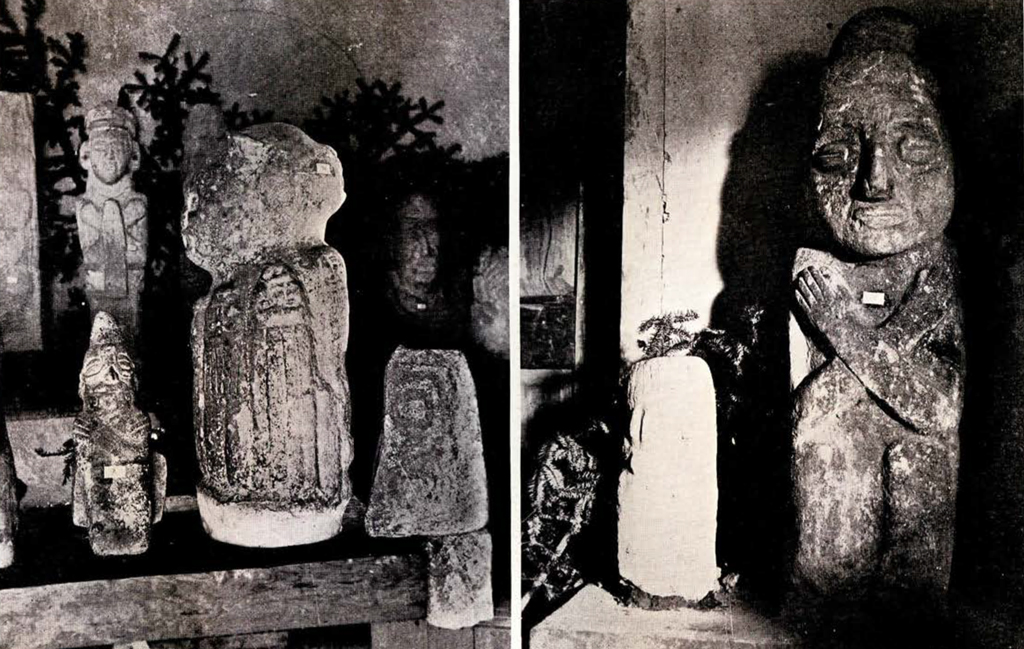
Image Numbers: 194586, 194587
Ther iz a moment in the morning when the sea ov clouds, iz transmuted into a distinct and level, but transparent, sea ov haze. Fotos 124 and 125, wer taken at that moment. The level horizon that you see in them, iz not the horizon ov any real sea, but ov the sea of haze. Remnants ov the former clouds float at the surface ov the haze, like icebergs in calm water: a little ov the bulk raizes itself above the surface, and shines in the sun. The fotografs (which ar most inadequat to the spectacle) ar taken, both ov them, not exactly from the clif, but from the hil on top ov the clif, the Sibinál hil. 124 over looks the same gulf az 123, but looks towards the right hand side, and the dark ridge rizing out ov the haze, iz the Bull Hil ridge. 125 iz in quite a different direction, looking some what north west : a direction which from the clif itself, would be impossible. The slope in front ov you iz the northern slope ov the mountain. At the bottom ov the haze ov course, iz the country ov the Tahumúlco bridle road, and ov the river Suchiáte. The iland that might seem to be surounded by icebergs, iz the peak ov the next volcano, the peak of Tacaná. And ov course to a spectator on Tacaná, Tahumúlco must hav a like apearance.
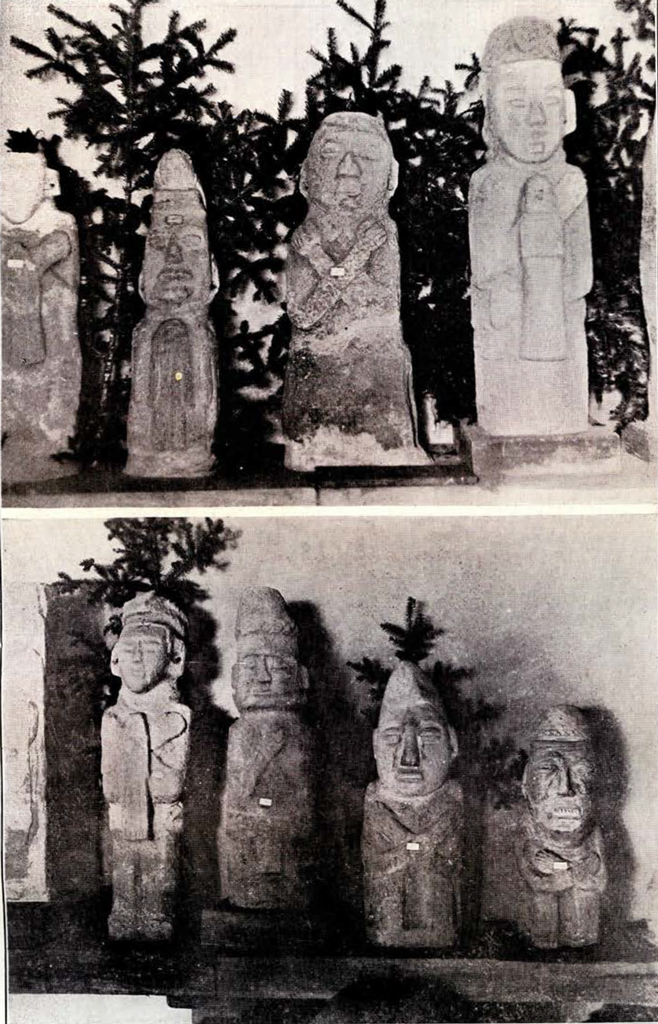
Image Numbers: 194580, 194582
The clif itself iz what you see a part ov in foto 126. A front fotograf ov the clif iz not feazible: the ground along the base being only a few steps wide. This foto iz a sidelong view, showing a jutting angle. The direction ov the view iz south westerly. The stony hil, with its top above the tree line, iz Conception Hil : and you can just see, to the right ov that hil, the foot ov the main peak ov the mountain. To take in some height ov the clif, however, the camera iz decidedly turnd up, and the distance deceptively sunk. The stone ov the clif, and ov the mountain, iz the same az ov the Chocolá stone, a hard grey lava. You see it some times in clifs, some times thrown about in huge angular blocks : and with surfaces, which however iregular, hav a remarkable tendency to be smooth :—not az smooth az a slate, by any means: but if you had something in your hand to make a mark with, smooth enough to invite scribbling. And ancient and modern travelers, at this way side clif, hav not faild to scribble on it.
The modern scribbling, which iz all close to the recess uzed az a shelter, iz in charcoal. The Indian after boiling hiz coffee and lighting hiz cigar, haz a coal in hiz hand: and he vexes the rock with a cross, or a face: or if he haz been taught to rite, then some times with the date. The ancient scribblings, or drawings, ar not in the same part ov the clif az the modern : and most ov them ar less accessible : and in stead ov being in charcoal they ar in colour: most ov them in red, a few in red and green. Yet the instant general impression that you hav ov them, iz that with whatever differences from the modern, they ar scrawls ov the same order, the idle occupation ov a moment. One ov them, however, iz ov a more ambitious aspect than the others, and not exactly to be calld a scrawl: and besides that one, I hav copied a few ov the best ov the others, that ar stil traceable, to let you see the apearance ov what I call the scrawls.
Az for the red and green colours ov the ancient drawings, I dont supoze for a moment, that the paints wer brought on purpose to paint the clif. If they wer not carried in the way ov trade, they veer most likely carried az cozmetics. In the case ov the drawings on the clif, however, you can see that the paint waz not sized dry, but az a liquid, and laid on with something like a brush or a feather.
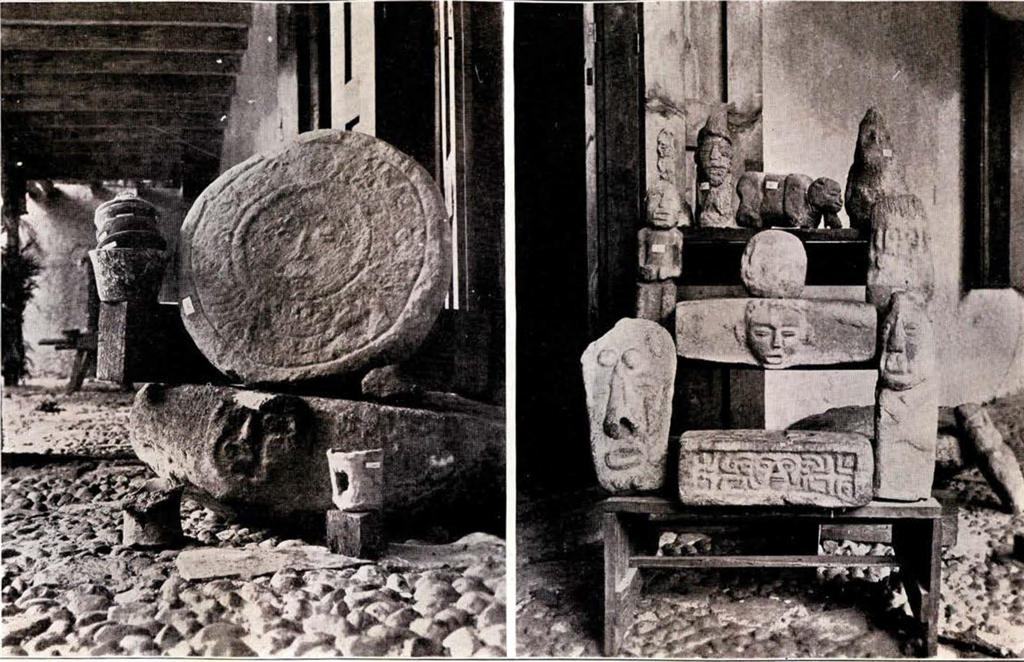
Why the paint waz not washt off by the first storm ov rain that beat against the clif, iz more than I can guess. Possibly it waz mixt with calabash varnish, the Indian waterproof varnish. But the fact cannot be seen. The paint now, iz protected from weather and from examination, by an act ov nature. The clif, or the hil above it, haz exuded a scanty amount ov something like a stalagmitic drip : which differs from that ov lime stone in being hard and glassy : and the stone, and the drawings, ar sheeted over with that glassy incrustation. Cover my copies with a sheet ov tracing cloth, shiny side up, and you will get a notion ov the apearance ov the incrustation. The incrustation (which iz perfectly dry) seems in many places to be as thin az paper, and transparent: but when it gets thicker, it haz a milky colour, and in some places obliterates the drawings. The drawings ar protected, but also in process ov being buried.
My copies ar made in outline, by tracing, and consequently ar full size: but ov course in many ways they ar defective. I wil mention two defects.
One iz a matter ov outline. The edge ov the paint iz too smooth. In the originals, when you get close to them, you find that the edge ov the paint iz usualy full ov small roughnesses, and uncertainties, cauzd by the roughness ov the stone. But my pencil in tracing, draws a precise line. All the small roughnesses ov the original (though not the larger roughnesses) have a tendency in the copy, to be smoothed out.
The other defect iz a matter ov colour. The red, which iz a bright red, and the green, which iz very near blue, ar fairly wel repre-zented, I think, by the colours I hay painted:—ov course ther iz no incrustation on them. But my back ground, that iz to say, the tracing cloth, iz a long way from the colour ov the stone. It iz a little better than white would have been, but it iz stil altogether too light: with the rezult that the paint stands out in a much more startling way, in my copies, than it does on the clif.
The distribution ov the drawings, on the clif, iz mainly in two tracts: a left hand tract (az you face the clif), and a right hand tract: and my copies ar from both tracts.

Image Numbers: 194562, 194556
In the last foto (126), if you look some distance up the clif, at the edge ov the sunshine, you wil see a man. He iz the highest up ov three men, all near the middle ov the picture. The left hand tract, that I speak ov, iz in the neibourhood ov that man: partly to the mans left, in the shadow; but mostly higher up than the man, in the sunshine on hiz right. The drawings in the sunshine wer very vizible from where you stand: but whether on acount ov the sunshine or the incrustation, or I dont know what, ther iz not the faintest sign ov them in the fotograf. All the marks you see ar other marks. The most conspicuous ov the drawings there, and one that I thought ov copying, waz a big clumzy square afair, which at a distance lookt something like this, but with something inside it. When you got up to it, however, you found that the inside waz shrouded in the-incrustation, and not to be made out. Among smaller things in the left hand trace, one waz a very small human head, partly in green, the only green in that hole tract ov the clif. And ther waz a quadruped which might be a dog. And just to one side ov the dog, and az if perhaps connected with it, waz a mark like this. Counting the tally marks (so to call them), you found them to be twelv : so that you might understand the hole thing az Twelv Dog: which ov course, in the antique system, might equaly be the name ov a day, or the name ov a person. The dog (or whatever it might be) waz in the sunny part ov the clif before you. And a little further out than the dog (and nearly level with the dog, but not aparently con-ected with it), waz an other drawing, not quite so bad, which waz evidently to be read az Three Deer: and my copy 808, iz ov that drawing.
The fotograf failing me, I am not able to point out the precise place ov the drawing. But in order to get to it, you climb to where the top man iz sitting, which iz on a narrow ledge: and finding foot holds further out, at the same level, you reach up to the dog and deer with your hand. They wer the two highest drawings, I believ, in the left hand tract ov drawings.
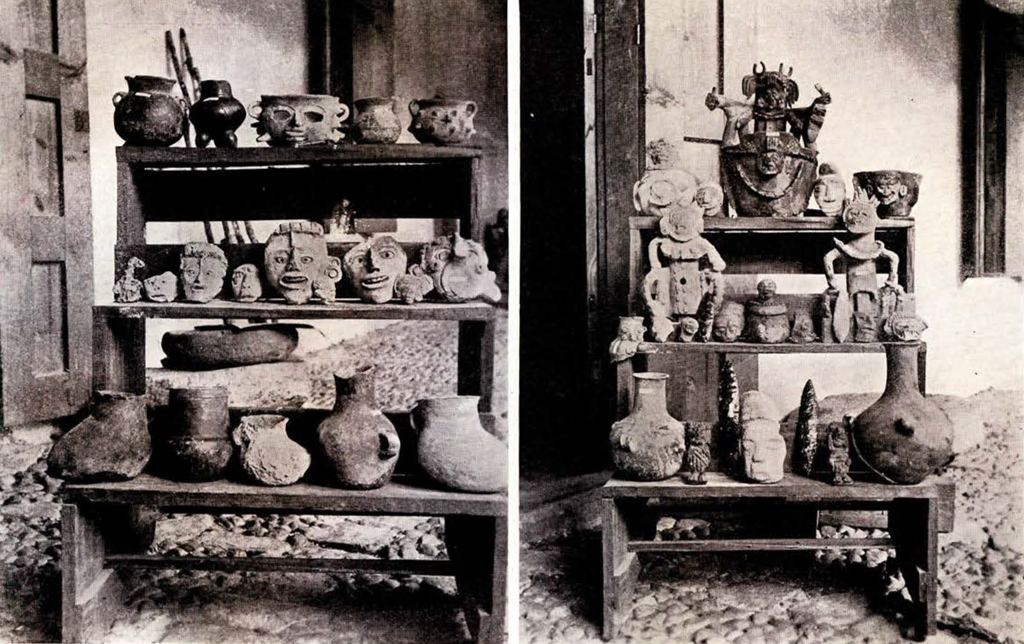
Image Numbers: 194567, 194570
The right hand tract, which iz much the smaller ov the two, iz invizibly included in the stretch ov clif ov the last foto, 126. You see in the nearer part ov the clif, a big rounded stone, with its note sticking out into the sun: the right hand tract ov drawings iz comprehended in a tall vertical facet ov the main rock, just on the far side ov that stone.
The deer waz a favourit animal on the clif, and apeard in several poor sketches, in this second tract. Ther waz no indication ov number with them, and you see the best ov them in 809. The hindmost leg ov the animal would seem to have been left unfinisht.
The other drawings in the same tract, wer ov a hieroglyfic nature, and three in number. One ov them, a small thing in red and green, waz hopelessly blurd by the incrustation. An other, which waz all in red, and not so much blurd, had the apearance ov what you see in 810. I might say that among the nine lines joining the inner and outer circles, the two finer lines that you wil notice, though I copied them, gave me the impression ov being mere stray brush marks.
The remaining drawing waz the big red and green one ov 811. About the green ov this drawing, you will notice that ther would seem to hav been some intention to uze the green more extensivly. In the left hand bottom corner, for instance, the space between the inside and outside frames, iz made green, but the green iz not carried round. My own fancy iz, that the painters first vague intention, waz to green the hole back ground, or a great part ov it. Then it waz seen that that would cauz an excessiv outlay ov green paint, and the experiment ov the green waz limited to narrow spaces.—Not that that would explain the green in evry detail: why should the bulls eye in the middle ov the picture, not be painted acording to the two examples in the right hand top corner? And why should the upper ribbon (so to call it) be chozen az a place for green, while I waz not able to see green in the lower ribbon: although that space iz continuous with the green space round the birds heads (or whatever thoze things may be)?
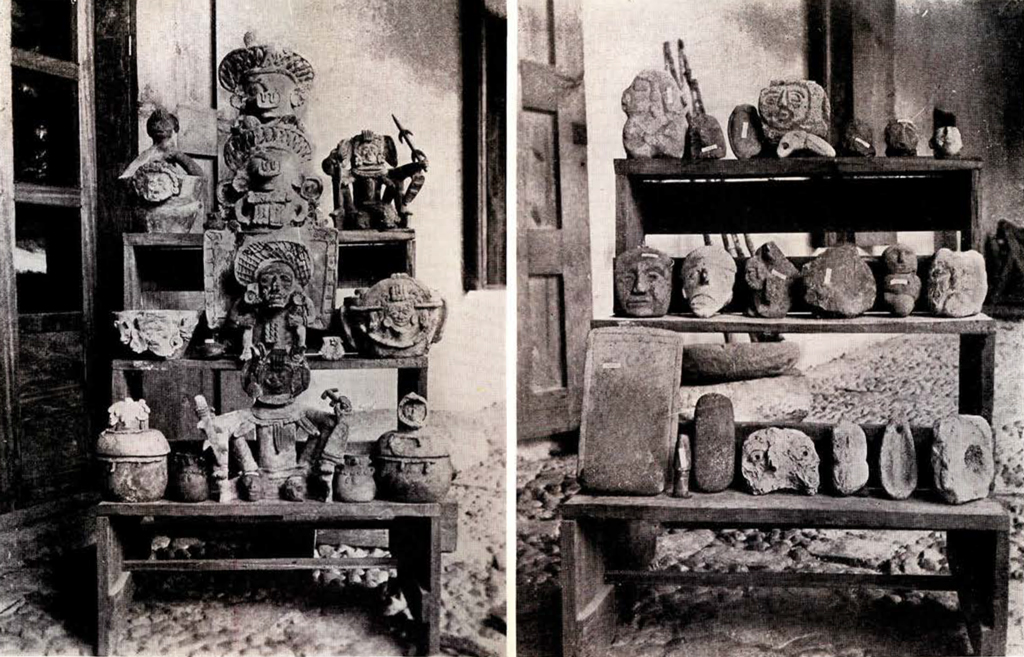
I hav told you that to reprezent the dark grey stone, variously blotcht and discolourd, the tint ov my tracing cloth iz altogether too light: and that defect, which iz not much matter when the drawing iz all the one colour red, becomes serious when you ad the green. The green, on the light ground, iz made to look much too important. On the clif, at a distance ov a few feet, you dont so much az see the green: all you see iz the red. The green blends with the grey ov the stone : it iz only when you get close to the stone, that you notice, under the incrustation, that Cher iz green. But the green on the tracing cloth looks az plain and certain az the red. Worse than that, in the prezence ov the green, the light tracing cloth falsifies your impression ov the red pattern. The red away from the green, iz made to look much more distinct than the red with the green beside it: which on the dark stone, iz not the case. To give you a right impression ov the pattern, and reduce the green to its proper inconspicuousness, the only remedy, I think, iz to darken all the blank part ov the tracing cloth, til it iz about the same darkness az the green. And until something like that iz done, I should consider the copy unfinisht. I hav no dout you wil find some artist at the muzeum, who wil be able to perform the necessary operation.
This last ov the clif-drawings, which I flatter my self—excepting for the probable day sign at the top—that even expert hieroglyfic-solvers wil confess to be something ov a pozer, waz the drawing that I hav mentioned az much the most ambitious, and in fact waz the one which alone lent intrest to the rest: and besides being conspicuous for its size, and complication, and ornateness, waz also conspicuously lonely. The drawings nearest to it, all the other drawings, or scrawls, on the same tract ov clif, wer down towards the bottom, in eazy reach ov your hand. This one, az if in contemt ov such companions, waz placed az far above them az the face ov the rock alowd : and could only be reacht, and must hav been drawn, from something like a ladder. That ladder might be ov the sort that I my self uzed in making my copy: a ladder cut from the surrounding pine-woods. But a drawing that required the making ov a ladder, could not hav been the work ov a moment, nor probably, ov a solitary passenger.
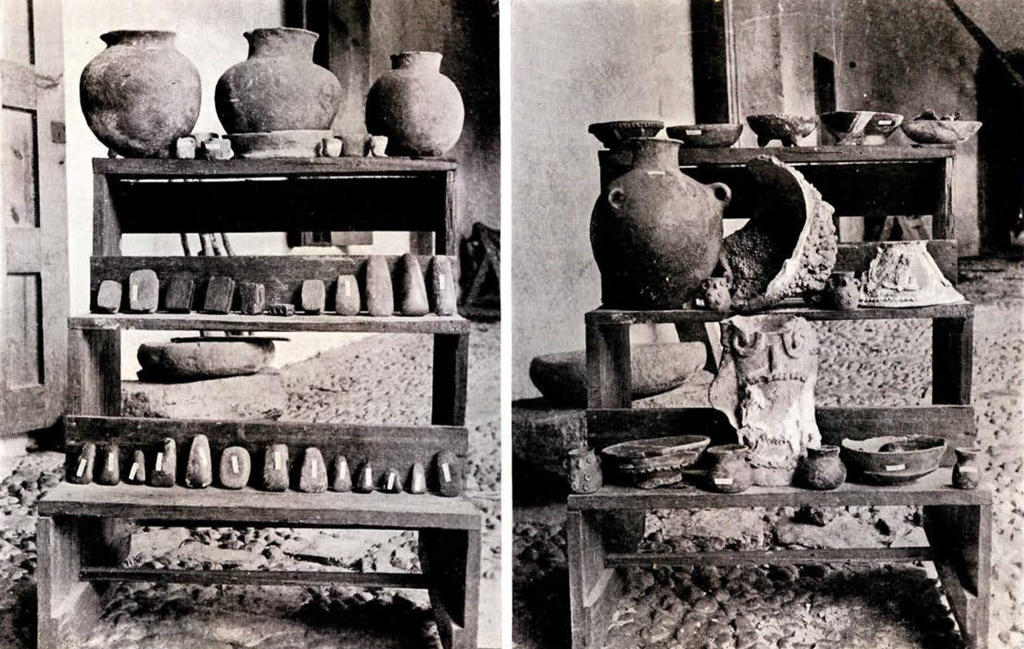
Image Numbers: 194564, 194563
Foto 127 [not shown] iz an atemt at fotografing the place ov the drawing: and at the intersection ov the lines AB and CD, you can make out something ov the drawing itself. In the distortion ov the drawing, you may judge how much the camera waz turned up.
Foto 128 [not shown], which I send both plain and enlarged, iz an atemt from further off. The drawing and its suroundings ar seen smaller, but less distorted. This second fotograf waz taken after my copying waz done, and contains a memorial ov it. The horizontal streak that you see, just over the drawing, iz the streak ov gum, with which my tracing paper waz hung on the rock. The other three sides ov the paper wer not gumd : I had to be able to lift the paper, now and then, to look through the incrustation. The incrustation, in this drawing however, waz not so troublesome az the wind: the wind so blew, that I had to hay a triple ladder, and a man on either hand to hold the paper down. I might ad, that when I waz done copying, I had my ladders chopt up: so that no passenger ov a Vandal inclination, should be temted to get up and meddle with the drawing. But the drawings ar protected by the incrustation and by superstition: and a future traveler wil probably see them (unless for some advance ov the incrustation) without a shadow ov change. He may even see my streak ov gum. A streak ov gum, in that situation, might last til the end ov the world.
Erratum
Under the illustrations on pages 138 to 145 inclusive, for Choculá read Chaculá.

